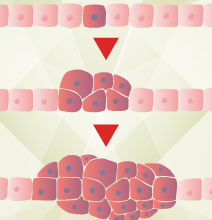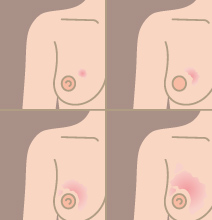Triple negative cancers
ER –
PR –
HER2 –
About 15-20% of all breast cancers do not have estrogen receptors (they are called ER-), progesterone receptors (PR-) and receptors for a protein called HER2 (HER2-). They are called triple negative breast cancers. This is important because these are the most common receptors stimulating breast cancer growth.
This also means that conventional breast cancer treatments that target these receptors – such as tamoxifen, anastrazole, trastuzumab – or those that target HER2 receptors, such as Herceptin, do not control these cancers. Nevertheless, other medicines can be used to treat triple-negative breast cancers, and they also respond well, in fact better than other tumors, to chemotherapy.
Triple negative tumors tend to be very aggressive – they appear earlier, grow and spread quicker and also have a higher recurrence risk that most other breast cancers. They are also often associated with hereditary cancers caused by mutations in the BRCA1 gene.
Much research is now being done on the biology of this type of cancer in an attempt to find new therapeutic targets to control it.





